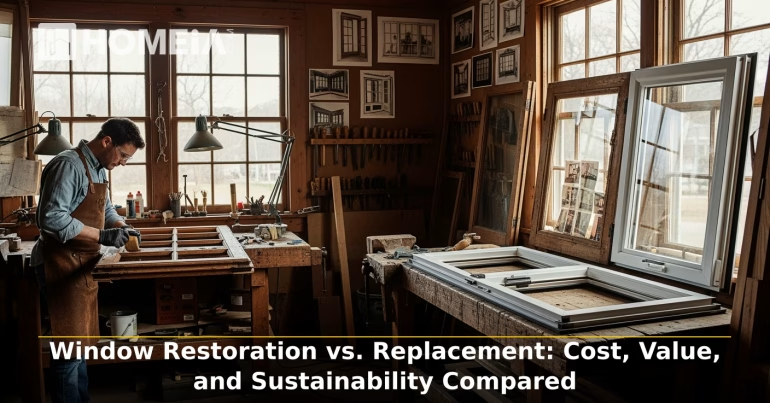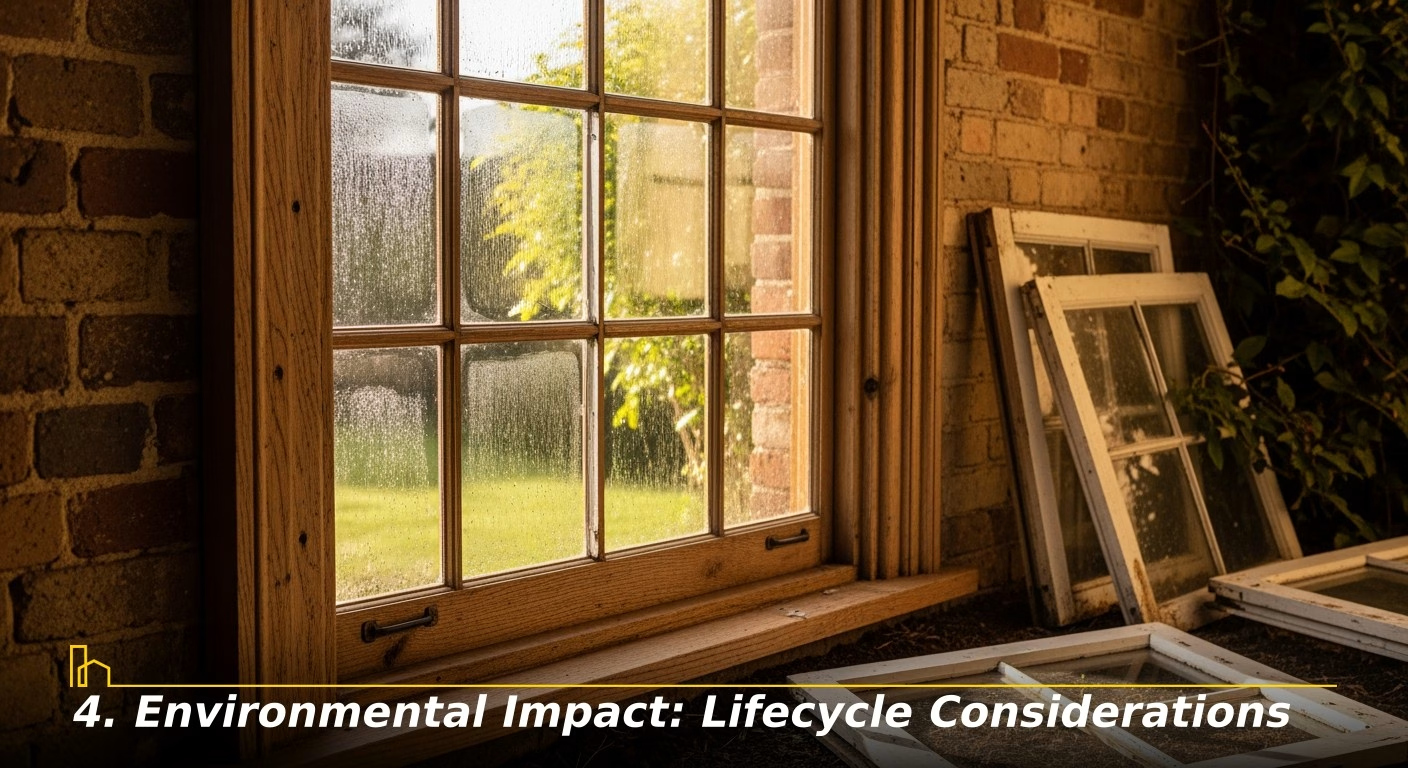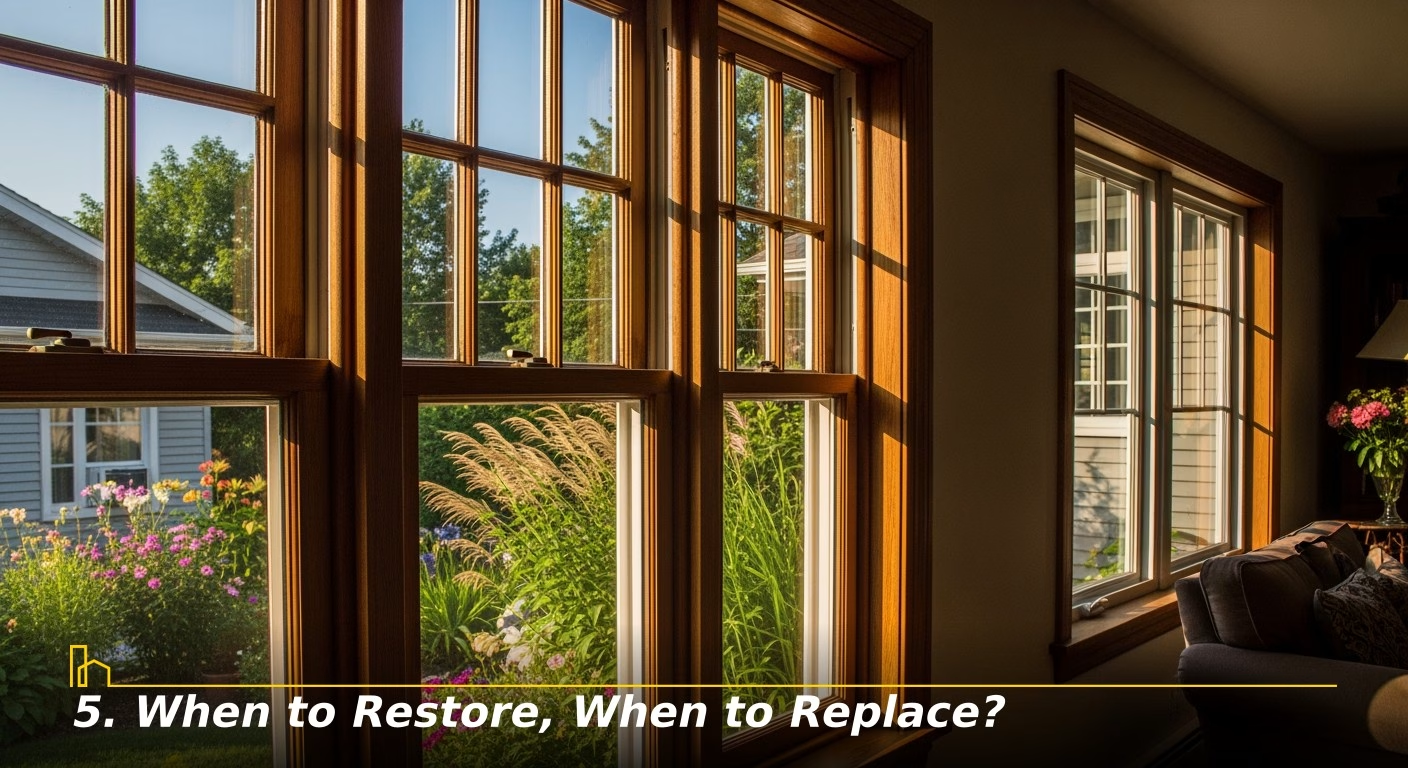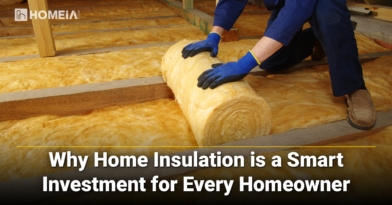Window Restoration vs. Replacement: Cost, Value, and Sustainability Compared
- Local Editor:Local Editor: The HOMEiA Team
Published: Nov 12, 2025
- Category: Home Improvement

When faced with drafty, damaged, or difficult-to-operate windows, homeowners confront a glaring problem: restore the original windows or replace with modern units. This decision involves weighing complex factors including financial investment, energy performance, architectural integrity, and environmental responsibility. For historic home owners, the choice is even more difficult as windows are fundamental to a building’s character.
Across the Midwest and especially in urban hubs, solutions like Chicago window restoration illustrate how combining historic preservation and modern performance can increase property value and sustainability. This comprehensive guide examines both paths in detail, providing the insights needed to make an informed choice that aligns with your home’s needs, your values, and your budget.
Windows serve as standout architectural pieces providing natural light, ventilation, and views, yet they represent serious weaknesses in a home’s thermal envelope. These openings allow substantial heat transfer — the desired warmth during winter months and despised heat infiltration during summer — directly impacting both comfort levels and utility expenses…Optimize Your Window for Energy Efficiency: Homeowners’ Guide
Table of Contents:
1. Cost Breakdown: Restoration Versus Replacement

A. Window Restoration Costs
Window restoration typically addresses specific components rather than the entire system. This approach can resolve most common issues at a fraction of replacement cost, with projects averaging between $300 and $550 per window, with a national average of around $400. Final cost depends heavily on the specific repairs needed:
Type of Repair | Average Cost Range | Common Issues Addressed |
|---|---|---|
| Weatherstripping | $100 – $600 | Draft reduction, energy loss |
| Sash Cord/Balance | $50 – $110 | Difficulty opening/closing |
| Window Frame Repair | $75 – $800 | Wood rot, decay, structural issues |
| Glass Repair/Reglazing | $75 – $200 | Fogging, cracked glass, broken seals |
| Storm Window Addition | Moderate investment | Thermal performance improvement |
B. Window Replacement Costs
Replacement costs fluctuate based on window type, material, and quality. 2025 industry data found that the national average ranges from $554 to $700 per window, with prices extending from $300 to $2,500 taking into account quality and customization. Full-frame replacements in historic homes often occupy the higher end of this spectrum due to custom sizing and potential architectural modifications.
Window Type | Average Cost Installed | Best Suited For |
|---|---|---|
| Vinyl Windows | $450 – $850 | Budget-conscious projects, non-historic homes |
| Wood Windows | $800 – $1,500 | Historic homes, high-end properties |
| Fiberglass Windows | $900 – $1,400 | Durability and insulation balance |
| Composite Windows | $1,000 – $1,800 | Mixed material benefits |
Replacement represents a crucial initial financial outlay. However, according to the 2024 Cost vs. Value Report, homeowners can expect nearly 67.1% return on investment for vinyl window replacement and approximately 62%-66% ROI for wood window replacement at resale.
C. Long-Term Financial Perspective
While restoration almost always wins on initial cost savings, consider the long-term perspective:
- Restoration uses existing materials and prioritizes labor, keeping money in the local economy and preserving high-quality original materials that have already proven their longevity.
- Replacement costs are heavily weighted toward materials and manufacturing, with most vinyl windows carrying warranties of 10-20 years and typical lifespans of 15-20 years. Premium fiberglass windows may last 30-40 years. In contrast, properly restored historic windows have often already lasted 50-100 years and, with basic maintenance, can last another century.
Energy-efficient replacement windows promise lower utility bills and a more comfortable living environment. Understanding the true savings and benefits is essential for homeowners considering window upgrades. This guide explores the financial, practical, and environmental impacts of investing in high-performance windows…How Much Do Energy-Efficient Windows Really Save? A Homeowner’s Guide
2. Energy Efficiency Analysis

A. The Performance of Properly Restored Windows
A prevalent misconception is that historic windows are inherently inefficient and must be replaced to achieve energy savings. In reality, a comprehensively restored window system can compete with new replacements. This can be achieved by addressing all points of energy loss through these proven methods:
- Weatherstripping: Modern weatherstripping materials applied to sashes and frames can reduce heat loss by 10%-15%, dramatically reducing drafts.
- Storm Windows: Adding interior or exterior storm windows creates an insulating air pocket that can reduce energy use by 20%-50%, with EPA estimates showing approximately 20% savings on heating and cooling bills for Energy Star certified storm windows installed over single-pane windows.
- Retrofit Double Glazing: For those wanting maximum performance, insulated glass units (IGUs) can be carefully inserted into original sashes, improving thermal performance by up to 40% while preserving historic woodwork.
- Maintenance: Quick repairs like reglazing, repairing damaged frames, and proper painting seal air leaks that account for most energy loss in older windows.
Research supports this approach. A 2002 field study by Lawrence Berkeley National Laboratory proved that installing a storm window over a historic window can achieve thermal performance similar to that of a new low-E vinyl replacement window. Additionally, it found nearly equivalent energy savings between restored wooden windows with storm windows and replacement units.
B. The Efficiency of Modern Replacement Windows
New windows offer built-in energy advantages through double or triple-pane glass, low-emissivity (Low-E) coatings, and advanced frame materials designed to minimize heat transfer. Energy Star certified windows can save homeowners anywhere from $125 to $465 annually on energy bills, depending on the region and specific conditions.
However, proper installation is critical. Even the most technologically advanced window will underperform if incorrectly installed. Doing so has the adverse effect, likely leading to air leaks.
Recommended for you
3. Historic Preservation and Property Value

A. The Value of Authenticity
Beyond mere aesthetics, original windows are integral to a building’s architectural character and historical integrity. Preservation-minded experts cite several compelling reasons for restoration:
- Craftsmanship and Materials: Historic windows were often crafted from old-growth wood, which is denser and sturdier than modern farmed timber. Their construction typically featured mortise and tenon joinery, an incredibly strong method that’s easily repaired.
- Custom Fit: Original windows were built specifically for their openings and have expanded and contracted with each season. With proper weatherstripping, they can seal even better than replacements.
- Authentic Glass: Historical windows often contain wavy glass or other period-specific types that cannot be authentically replicated.
- Architectural Integrity: Replacement windows, especially in historic properties, can lower architectural value and reduce resale appeal.
B. Impact on Property Value
Homes with well-preserved historical features, including original windows, often command higher property values. Ideally, preserving original windows will provide financial benefits beyond resale value. The Federal Historic Preservation Tax Incentives program provides a 20% federal income tax credit for qualified rehabilitation expenditures on income-producing certified historic structures.
Understanding the process of window glass replacement, knowing when to replace your windows, and learning how to replace window glass in an aluminum frame can empower you to maintain the health and aesthetics of your home efficiently. This article aims to provide you with the information you need to navigate these issues…A Comprehensive Guide to Residential Window Glass Replacement
4. Environmental Impact: Lifecycle Considerations

When evaluating the environmental impact of window decisions, it’s essential to consider the complete lifecycle—from manufacturing and transportation to disposal and longevity.
A. The “Embodied Energy” Argument
Restoration is fundamentally a conservation-based approach maximizing existing resources. Historical windows contain substantial “embodied energy”— energy originally consumed to harvest, manufacture, and transport them.
- Manufacturing Impact: Production of new window materials has substantial environmental effects. Research indicates that a single new window has an embodied energy of approximately 2,300,000 BTUs for production alone.
- Landfill Waste: Window replacement generates substantial waste. Given that many historic windows were crafted from high-quality old-growth wood, this represents a waste of durable materials that are no longer readily available.
- Transportation Emissions: Sourcing windows locally can reduce transportation emissions, but restoration dramatically minimizes carbon footprints.
Analysis from preservation experts suggests that considering the total embodied energy, it can take 6-20+ years before a new replacement window begins saving net energy compared to properly restoring and weatherizing an existing window with storm windows.
B. Material-Specific Environmental Concerns
- Vinyl (PVC): Polyvinyl chloride production creates environmental concerns. When burned, PVC releases toxic dioxin.
- Wood: A renewable resource requiring maintenance but comes from natural sources. Original wood windows represent already-harvested materials.
- Aluminum: Highly durable and recyclable but energy-intensive to produce initially.
- Fiberglass: Offers exceptional insulation and durability with a relatively lower environmental impact compared to some alternatives.
Discover the Long-Lasting Benefits of Insulating Your Home. Join us as we explore the top six reasons why insulating your home is not just a wise decision, but a financially savvy one. From slashing energy bills to boosting your property’s value, we’ll uncover how this seemingly simple upgrade can transform your home and save you a small fortune in the long run…Why Home Insulation is a Smart Investment for Every Homeowner
5. When to Restore, When to Replace?

A. Clear Cases for Restoration
Prioritize restoration when:
- Your home is designated historic, or appreciate craftsmanship and authenticity
- Windows are fundamentally sound with only specific repairs needed
- Budget is a primary concern
- Environmental sustainability is a priority
B. When Replacement May Be Preferable
Consider replacement when:
- Severe structural damage exists beyond salvage
- Modern convenience is the priority or historical authenticity isn’t valued
- Energy upgrades are needed throughout the entire home
- Original windows are already gone and this is a non-historic home
Conclusion: Decision-Making Framework
Choose restoration when windows are structurally sound, your home is historic, or you value authenticity, budget-friendliness, and sustainability. Opt for replacement with severely damaged windows, modern convenience, or in non-historic homes. Weigh your windows’ condition, the home’s historical value, budget, and energy goals. For most mature properties, restoration preserves character and value, while replacement may better suit modern needs in other contexts. Invest in quality workmanship for lasting results.
Recommended for you
Frequently Asked Questions about Window Restoration vs. Replacement
1. Can restored historic windows be as energy-efficient as new windows?
Yes. With proper weatherstripping, storm windows, and maintenance, the thermal performance of restored historic windows can be comparable to new replacements. A 2002 Lawrence Berkeley National Laboratory study confirmed that installing storm windows over historic windows achieves similar thermal performance to a new low-E vinyl replacement window.
2. How can I tell if my historical window frames are rotting?
Signs of rot include soft, spongy wood that may have dark stains and emit a musty smell. Gently test suspicious areas with a flathead screwdriver—if the wood feels soft or breaks away easily, it’s time for restoration. Addressing rot early prevents more extensive damage.
3. Are replacement windows bad for historic homes?
While not inherently “bad,” replacement windows often compromise historic authenticity. They typically have thicker frames reducing glass area and light, may not match original profiles, and usually lack the craftsmanship of originals. Inappropriate replacements can diminish architectural integrity and potentially reduce property value for buyers seeking authentic historic homes.
4. What are the environmental benefits of restoring rather than replacing?
Restoration preserves existing materials (keeping them out of landfills), eliminates manufacturing impacts of new windows, and requires less transportation energy. This “green” approach honors the sustainability principle that “the greenest building is the one that is already built.” Research shows it can take 6-20+ years for a new window to overcome environmental debt from manufacturing and deliver net energy savings.
5. How long does window restoration typically last compared to replacement?
Properly restored historic windows made from old-growth wood can last another 50-100 years with basic maintenance. Most vinyl replacement windows have lifespans around 15-20 years with warranties of 10-20 years, meaning restored windows often have a significantly longer lifespan and better long-term value.
HOMEiA is a city guide site where visitors can find detailed information about communities of interest. HOMEiA’s City Guides, created in partnership with local writers and editors, are curated lists of the best, safest, and most affordable places to live. The guides feature the HOMEiA Score, a proprietary index that rates communities on such factors as housing costs, education, employment, etc.
HOMEiA.com aims to be the premier site for people planning to relocate, providing them with insightful content and connecting them with skilled real estate professionals.
We also empower real estate professionals to establish or strengthen their web presence by highlighting their experience, knowledge and achievements. If you’re selected to join our list of certified real estate professionals, you will distinguish yourself from your peers — and earn HOMEiA’s support.
If you believe in HOMEiA’s mission, please share our website with others.








































































































































